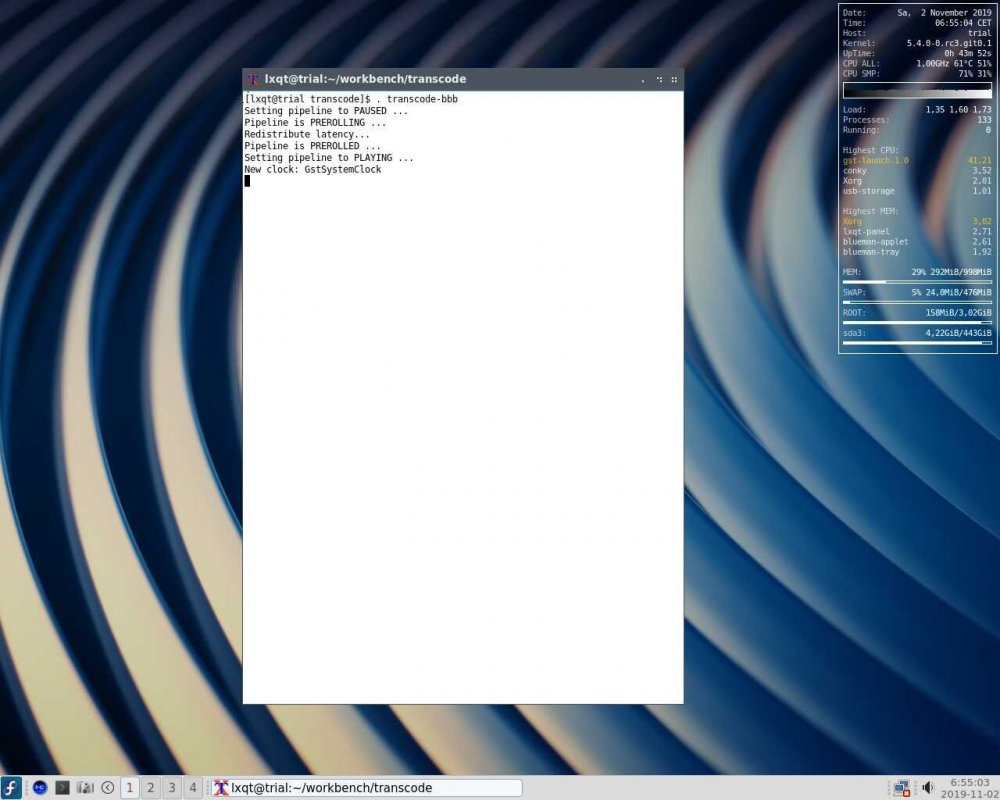
usual user
Members-
Posts
423 -
Joined
-
Last visited
Content Type
Forums
Store
Crowdfunding
Applications
Events
Raffles
Community Map
Everything posted by usual user
-
OK, now that you described your network topology in more detail it is obvious what is going on. Your router does not connect the WiFi and Ethernet segment in bridged mode but handles them as two separate segments where routing takes place and firewall rules get applied. Ports for service discovery (mdns) and LPR (printer) seem to be enabled already but for ipp-everywere or aiprint (ipp) are not. With all properly setup and cups-browsed from the cups-filters package running there should be no user intervention be required to add the printer. cups-browsed will discover it, setup a suitable queue and in applications it will show up as printer to use.
-
Now you know you have a proper working CUPS. As hubs, switches or bridges usually do not apply any firewall rules if the devices are in the same network segment, there is nothing you should blame your router for. Having *no* print spool service on a device is quite common and rightfully a firewall does not open any ports for any specific print communication by default. Service discovery has primary nothing to do with print protocols. It is e.g. done by zero-conf (avahi) using different ports. And as it is being used by several services it is quite common a firewall has the involved ports open by default. To check if the firewall on the OPi is the culprit, temporary disable it entirely and try printing via network again.
-
As can be seen from the log (Executing backend \"/usr/lib/cups/backend/dnssd\"...) the cups backend is been started over and over again without succeeding in transfer any data to the printer. Maybe e.g. some firewall rules or something else network related is not setup properly. To approve this, connect the printer via USB and check if printing is working then.
-
First step would be to enable "Save debugging information for troubleshooting" in the administration tab and inspect the log files.
-

Cubox-i does not boot anymore after power shutdown
usual user replied to Aoz's question in Other families
Does the image provided ---there---, put on a separate microSD with "xz -dcv Fedora-Minimal-armhfp-31-1.9-trial.raw.xz > /dev/sdX", boot for you properly? "/dev/sdX" has to be replaced by the device where the separate microSD resides while the transfer. -
Screenshot while transcode pipeline is running on the HummingBoard-i2-i-MX6-Dual-Lite. See conky panel for performance values.
-
https://linuxtv.org/irc/irclogger_log/v4l?date=2019-11-01,Fri&sel=38#l34 \o/
-
If I looked this up correctly from the i.MX 6Solo/6DualLite Applications Processor Reference Manual the VPU has this specs: HW Decoder: H.264 Profile: BP/CBP/MP/HP Resolution: 1080 i/p, 30 fps Bitrate: 50 Mbps HW Encoder: H.264 Profile: BP/CBP Resolution: 1080p, 30 fps Bitrate: 14 Mbps As the VPU is a dedicated IP the number of CPU cores does not matter for the codec performance and 1gb should suffice to provide the required buffer allocations for the intermediate frames. Just composed my first transcode pipeline, see transcode-pipeline.pdf for reference. I do not really know what I am doing (google was my friend) and there are so much knobs for configuration and fine tuning so YMMV. transcode-pipeline.pdf
-
As the mentioned features are properties of the SoC it does not realy matter at which device the i.MX6 resides. Chose what fits your needs. As already stated to have all features out the box you need at least kernel 5.4.0-rc1. The rootfs distribution does not really matter as long as it provides software of the latest mainline releases. I tinker with cubox-i and hummingboard and as I wanted all bells and whistles I chose the quad variant with 2GB ram for me. This is working for me since round about fedora 26. OK, in the early days many of early adopter patches were required. But nowadays only proper configuration is necessary.
-
You have to start here: https://www.kernel.org/doc/html/v5.3-rc3/usb/gadget_printer.html
-
On imx6q SoC there is: v4l2-ctl --device=/dev/video0 --all v4l2-ctl --device=/dev/video1 --all v4l2-ctl --device=/dev/video10 --all /dev/video10 requires at least kernel 5.4.0-rc1 to work out of the box. gst-inspect-1.0 exposes: So hardware accelerated video pipelines can be composed in all flavors.
-

Cubox-i does not boot anymore after power shutdown
usual user replied to Aoz's question in Other families
In fedora these changes can`t land since the kernel is universal and device specific buildins are not allowed to prevent vmlinuz bloat. An initramfs is only required if you have an encrypted rootfs or want to use UUID or LABEL for rootfs identification. For this to work you need user space tools. The initramfs is highly rootfs dependent hence it is almost ever created on the fly while kernel package installation in the running system. Doing it in an offline manner is quite difficult if not impossible. For a not encrypted rootfs with PARTUUID the kernel can always find the rootfs as long as it has buildin support to access the rootfs. No matter at what block device the rootfs resides the kernel will find it. IMHO a distribution building device dedicated kernels should try to avoid using an initramfs. Without an initramfs installing a kernel boils down to copy preassembled files in place and point the boot loader at them. It can be done easily in an offline manner to recover a system and is rootfs independent as long as the files are copied in the correct location. I have done it with the fedora kernel to bootstrap the minimal armbian image. As a fly by, I thought I should report some observations. I don't care enough for armbian to get this included. An armbian supporter has to take over here. -

Cubox-i does not boot anymore after power shutdown
usual user replied to Aoz's question in Other families
Boot without initrd with the current config-5.3.1-cubox is not possible. In fedora config I need at least to flip CONFIG_MMC_BLOCK, CONFIG_MMC_SDHCI, CONFIG_MMC_SDHCI_PLTFM and CONFIG_MMC_SDHCI_ESDHC_IMX from module to buildin to be able to boot without initramfs from mmc. -

Cubox-i does not boot anymore after power shutdown
usual user replied to Aoz's question in Other families
If you have copied in /boot/vmlinuz-5.3.1-cubox, /boot/initrd.img-5.3.1-cubox, /boot/dtb-5.3.1-cubox/ and /lib/modules/5.3.1-cubox/ from your new SD install of 5.3.1 your only missing part should be to copy in the attached /boot/extlinux/extlinux.conf. extlinux.conf -

Cubox-i does not boot anymore after power shutdown
usual user replied to Aoz's question in Other families
Dropping the bare image on the micro SD starts with working HDMI support. Maybe it is the different content of the initrd as that is the only difference to the previous used image kernel wise. But it is loading the wrong DTB (for cubox-i, not for hummingboard) and there is no visible cursor in the VT. Dropping in the attached /boot/extlinux/extlinux.conf fixes this. The first boot stanza doesn't even matter as uboot recognizes the missing files and gracefully skips to the second stanza. This gives a nice snappy desktop. extlinux.conf -

Cubox-i does not boot anymore after power shutdown
usual user replied to Aoz's question in Other families
Your log shows the device is equipped with 1G of RAM, hence no cma is reserved. Etnaviv support should not be working, you probably need "cma=256M@1G" as a workaround. -

Cubox-i does not boot anymore after power shutdown
usual user replied to Aoz's question in Other families
OK, figured what was going on. First step was to reinstall the armbian uboot from /usr/lib/linux-u-boot-next-cubox-i_5.98_armhf again. It has full distro boot feature available. I was mislead by a comment (# next kernels have different u-boot without autodetection) in /boot/boot.cmd. In the end uboot is setting up the boot parameters in a not suitable manner for my environment. And "Starting kernel ..." as the only feedback is not of much help to analyse the problem. I came up with the append line setup of the first boot stanza in /boot/extlinux/extlinux.conf to boot successful in my environment. In serial.log you see an automatic recover from a failing boot. Initially the fourth boot stanza is selected with boot parameters derived from /boot/boot.cmd. This is failing with "Starting kernel ...". After a while the watchdog kicks in and triggers a reset. Uboot restarts and autoboots the first boot stanza. The attached extlinux.conf can be used for the Armbian_5.98_Cubox-i_Debian_buster_next_5.3.1_minimal.7z as is. For other images the PARTUUID has to be adopted. "blkid" will tell you the proper value of your rootfs partition. serial.log extlinux.conf -

Cubox-i does not boot anymore after power shutdown
usual user replied to Aoz's question in Other families
What I have done with my exercise is to approve that the 5.3.1 kernel is really broken and missing some proper build config. See serial.log for reference. As uboot, kernel and rootfs have no hard dependence they can be exchanged independently. I have replaced uboot with a fedora one, dropped in a fedora kernel and an 5.2.10 armbian one. With distro boot I can select witch kernel to use at boot time. The 5.3.0-rc1 fedora kernel approves that the rootfs is flawless working with HDMI support. My distribution of choice is fedora and I am used to build kernels that sometimes break, like just 5.4.0-rc1 recently. But as I keep always a working kernel in place, it is only a matter of reboot to recover. serial.log uboot.tgz -

No HDMI with linux-image-dev-cubox (Kernel 5.2.11)
usual user replied to v-man's question in Other families
As Weston introduces some unnecessary indirection, using kms/drm with proper zero copy video pipeline maybe provide better performance. This is working for me like outlined in my first post. Only heavy scaling could be a problem as the support for hardware scaling has just landed in 5.4. I don`t know if ffmpeg has support for it (so Kodi can profit), gstreamer1 can use it already. You unfortunately did not gave enough information to help you any further. -

Cubox-i does not boot anymore after power shutdown
usual user replied to Aoz's question in Other families
Wondering what this is all about. Out of curiosity I downloaded Armbian_5.98_Cubox-i_Debian_buster_next_5.3.1_minimal.7z and took a look. The bare image does indeed not boot on my Hummingboard. Ok, lets copy over the fedora /usr/lib/modules/5.3.0-0.rc1.git0.1.fc30.armv7hl directory. As I have long time not tinkered with boot.cmd, boot.scr lets switch over to distro boot and drop in an /boot/extlinux/extlinux.conf. Wow, the armbian uboot recognized it, but with missing DTB autoselect this is not of much use. Replace the uboot with a mainline one like used by fedora. Now the image is properly starting up with HDMI support working. Dropping in a stanza for the image provided kernel confirms the 5.3.1 kernel gets stuck early while booting. A kernel from the Armbian_5.94_Cubox-i_Debian_buster_next_5.2.10_minimal.7z is properly booting, but only usable via serial console. The HDMI support seems to be missing. I ended up with the attached extlinux.conf. As I had to collect the armbian kernel command line parameters manually, there is a possibility I messed something up. But none of them should prevent booting up the kernel. extlinux.conf -

No HDMI with linux-image-dev-cubox (Kernel 5.2.11)
usual user replied to v-man's question in Other families
The current fedora kernel config is here: https://src.fedoraproject.org/rpms/kernel/blob/master/f/kernel-armv7hl.config -

No HDMI with linux-image-dev-cubox (Kernel 5.2.11)
usual user replied to v-man's question in Other families
You wrote that Kodi does not perform for you under Weston. Out of curiosity, with the kodi-gbm package installed, how does Kodi perform launched by a text console user in a virtual terminal. The user should be a member of the video, audio and input group.

